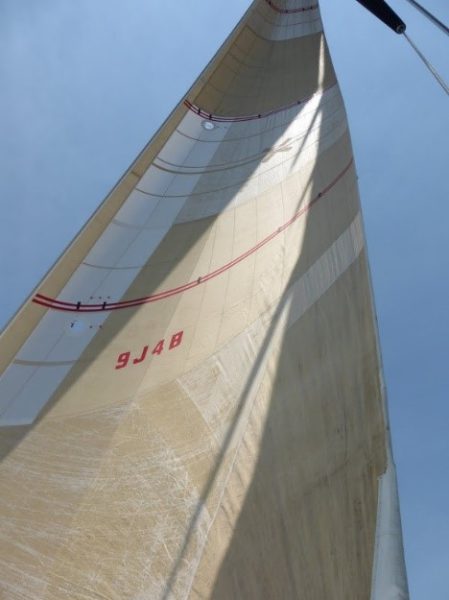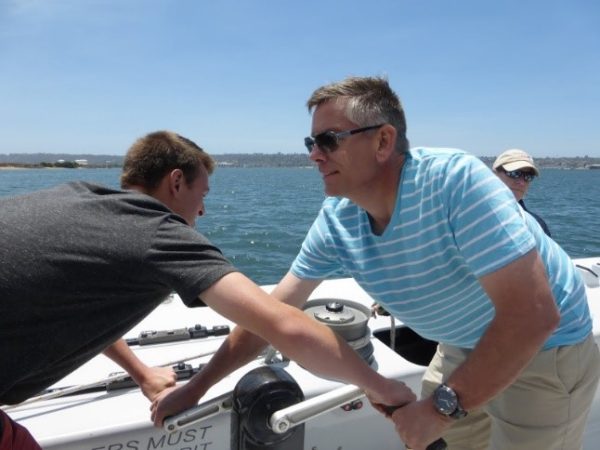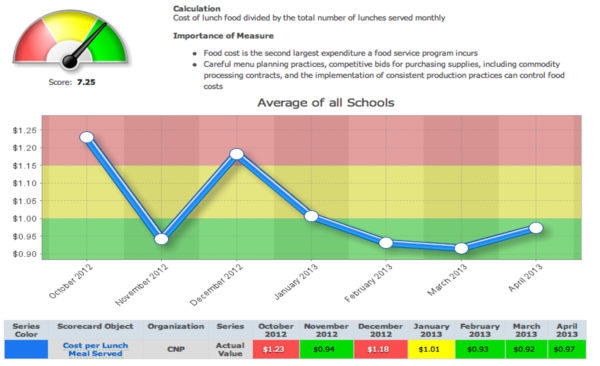
I decided for my son’s graduation present to take him on a “motor head” weekend extravaganza in California. If you knew me, you would laugh at the thought of me and the word “extravaganza” in the same sentence – but that’s exactly what we did.
With help from my wonderful wife, a detailed itinerary was drafted, printed and made into a book to guide our father–son trip (to reduce the amount of awkward guy time). As the dates drew near for our trip, we had settled on several stops filled with cars, awesome restaurants, beaches – and even an aircraft carrier. Also, at the recommendation of my wife, a last minute sailing trip was added.
I have to admit that I was very reluctant of the idea of going on a sailboat. My previous exposure to sailing was next to nothing. What if the boat sank? What if I got attacked by a shark? Worse yet – what if I dropped my phone in the ocean? No, thanks! However, I was able to fight back those fears and a refocus on being the “cool, fun dad” that I envision myself to be. I let go of my hesitations and we booked the trip.
 Stars and Stripes was the name of the sailboat. After learning how the boat was built and understanding that with a 13–foot keel weighing 40,000 pounds under the boat, I had essentially just boarded a large Weeble wearing a cape (if you are my age you may have understood that reference). My fears of the boat going down were greatly alleviated.
Stars and Stripes was the name of the sailboat. After learning how the boat was built and understanding that with a 13–foot keel weighing 40,000 pounds under the boat, I had essentially just boarded a large Weeble wearing a cape (if you are my age you may have understood that reference). My fears of the boat going down were greatly alleviated.
I have to admit, looking at the boat, the crew and the other passengers, it didn’t take me long to understand why people love sailing. What more could you ask for than cruising through the water on a beautiful day powered by nothing but the wind – all while getting the satisfaction of seeing a group of individuals work as a team to make it all happen? What an experience!
From the hoisting of the sail to the steering of the boat, everyone worked as a team to move that boat through the water. I love scenarios where everybody has a task, a place to be and singular goal to achieve. I learned a lot thanks to the boat’s crew who truly loved sailing.
Of all of the sights, sounds and feelings I experience on the boat, there was one thing that I can’t get out of my mind. My son and I were positioned on the boat and our task was to crank on one of the boats wenches to “jibe” the head sail from one side of the boat to the other. As we cranked on the wench, one of the crew told me to look up at the sail. In three locations on the sail, there were these small pieces of string.
He told me that when they are parallel to the water, you have a happy sail. “Interesting,” I thought to myself. It wasn’t until the owner of the boat told me later in our trip that those small pieces of string are called “tell-tales.” The light bulb went off in my head and I got it.
The small pieces of string placed in three places on the sail provided the crew the information to see if they were fully utilizing the sail for the wind that was provided. They were indicators to let the crew know what to address to get the most out of the sail and the wind. If the tell-tales were not parallel to the water, the captain would steer the boat to correct – or the captain would have the crew “jibe” the head sail to better utilize the wind – or the crew would tighten the tension on the sail to reduce drag.
The small and seemingly insignificant pieces played a  large role in a successful day of sailing. This was proven as we flew past another sailor who was complaining that there was no wind at an impressive speed of 10 knots (about 11 and a half miles per hour).
large role in a successful day of sailing. This was proven as we flew past another sailor who was complaining that there was no wind at an impressive speed of 10 knots (about 11 and a half miles per hour).
So back to my original question: How do you tale?
In my world at LEAN Frog, our term for tell-tales is key performance indicators or KPIs. Why do I care about KPIs? They’re extremely important because people use them every day. From the instruments in your car, to the state of your stocks, to the statistics of your favorite sports team, people use KPIs every day.
I bet some of you even have KPIs displayed for you on your wrist and get that satisfied feeling when your Fitbit notifies you that you’ve reached your fitness goals for the day. KPIs help us determine where we are and help us act to adjust our actions to improve.
At LEAN Frog, our mission is to help school systems improve performance, save money and provide the best learning environment that they can for students. We preach the importance of KPIs everywhere we go to encourage continuous improvement for school systems to perform at the highest level possible.
In other words, KPIs are financial or non-financial metrics used to measure, control and improve performance with respect to an organization’s goal. The principles on which KPIs are defined are as follows:
• Quantitative and measurable
• Goal-based
• Process-based
• Strategy-based
• Time-bounded
We sometimes define KPIs using the acronym – SMART:
• Specific
• Measurable
• Achievable
• Relevant
• Time-bounded
It does not matter how big or small the school system is – knowing what KPIs to watch and teaching the ability to adjust through continuous improvement is what has enabled LEAN Frog to contribute to over $80 million in savings for school systems over the years to benefit their students.
Encourage your school system use their “tell-tales” to help them successfully navigate through any conditions while working together as a team. Happy sailing!
– John Higginbotham, PMP, BB